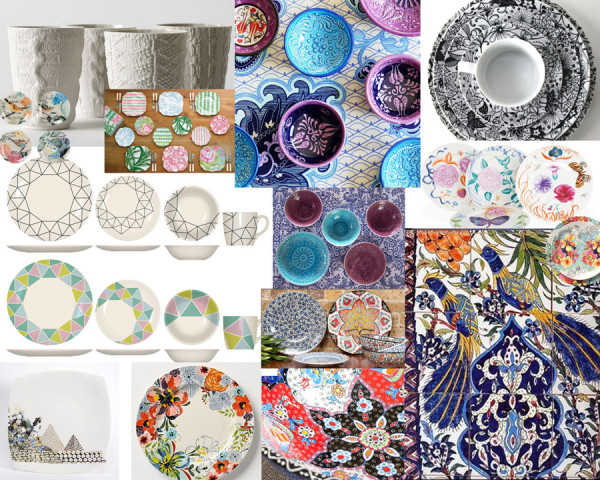I’d like you all to give a big welcome to my guest posters today, Lesley and Harriet Stevens of Decorque – a family-run business based in the UK specialising in home decorator wares and accessories. Take it away Lesley and Harriet!
*
Surface pattern on ceramics is something we have always been fascinated by and interested in, as it is part of our daily life and jobs. From tiles to crockery surface, pattern appears to have made its way onto nearly all surfaces.
In England no other pottery has reflected the spirit of the age in both design and surface pattern than Poole Pottery. From Art Deco in the 1920s and 1930s, the clean modernist look of the 1950s, to Pop art and the contemporary of today; it has always been famous for its colourful hand painted florals and pattern.

poole pottery
Swedish artist Stig Lindberg used a similar technique to Poole pottery painting directly in glaze and there are striking similarities in these 1950s examples. We love the use of unusual shapes complemented by surface pattern.

Stig Lindberg ceramics
At Decorque HQ we have our own collection of Poole, mainly from the 1960s. It is that distinctive matt ivory glaze that makes the pattern look so fresh; almost as if it has just been painted. Honiton have a similar look and combined it with great practical design, having the cream jug stack neatly on the sugar bowl when not in use.
The black and white checked jug with grapes is a Laura Ashley, a bit of a find if authentic, as it is hand painted and made exclusively for the company in Thailand we believe. The way we use pattern can enhance shape, and we really like the pattern coming down from the frilled edge of the vase.

The final choice from our extensive cabinets of pottery is where the surface pattern is in relief, bringing depth and texture to pieces. The leaves cover the rabbit and the birds hang on to eat the seeds, neatly bringing together surface pattern and structure.
Other approaches we really like are that of modern ceramics given an older more traditional feel, like the bright Turkish-influenced bowls from Target (UK). The colour combinations are really exotic and I love the pattern on the inside opposed to the exterior. Despite their simplicity there is something similar in their design to that of the amazingly detailed bowls we found on Achica.
Below we have created a moodboard showcasing some of our favourite alternative surface pattern approaches.

ceramics – current trends in surfaces
(
Many designs on crockery nowadays take the modern approach in contrast and feature a cleaner shape of plate with a stylistic, simple geometric or a design that falls to the edge of the plate. Also a trend that we have seen lately is using a photographic print mixed with watercolour or hand-drawn approach to bring a digital edge to dinner ware, like designs by Zara Home and Anthropologie. Plenty of examples can be seen on Decorque’s decorative home accessories board on Pinterest.
An emerging approach that we have also seen recently and at a few trade fairs is mixing two surface patterns together, from different sets and creating a juxtaposed combination of patterns. See these examples by Seletti). Called Hybrid, they interlink two distinctive design styles to create a very eye catching, distinctive collection. Could this be the way surface pattern heads towards for homeware, and that one style is just not enough?

Seletti
About Decorque:
At Decorque we love colour and pattern and seek to bring a creative touch into your home through our products. A family-run business, based in Oxford UK we bring you uniquely designed decorative home accessories and unique cards and gifts. We also run a successful creative blog (blog.decorque.com) where we like to share our likes and loves across all design topics.

Not sure that I like the two styles combined but I love that the design is making me think a bit harder!
P.S. Starting to think I do like it now… 🙂
Yes Anna, it took me a little while to get my head around the Seletti pieces too, but I DO like them!!